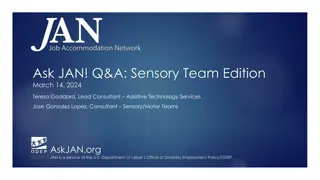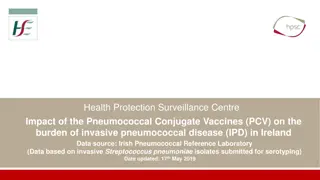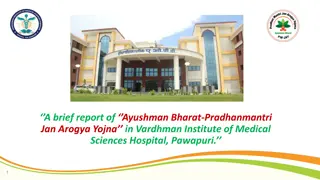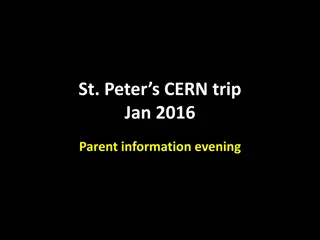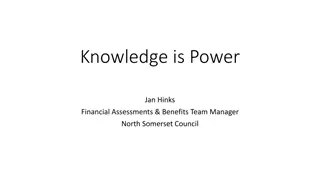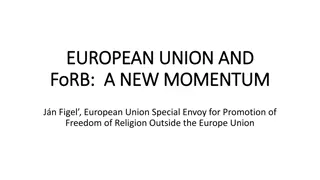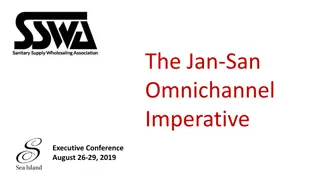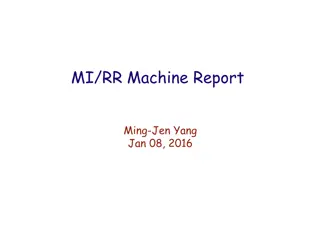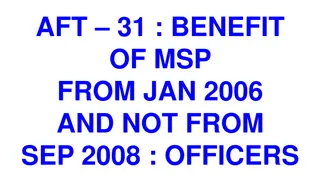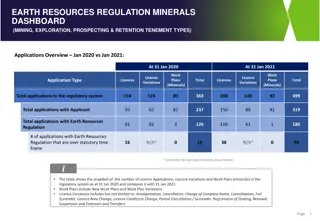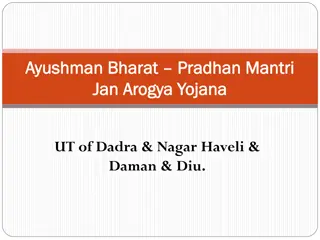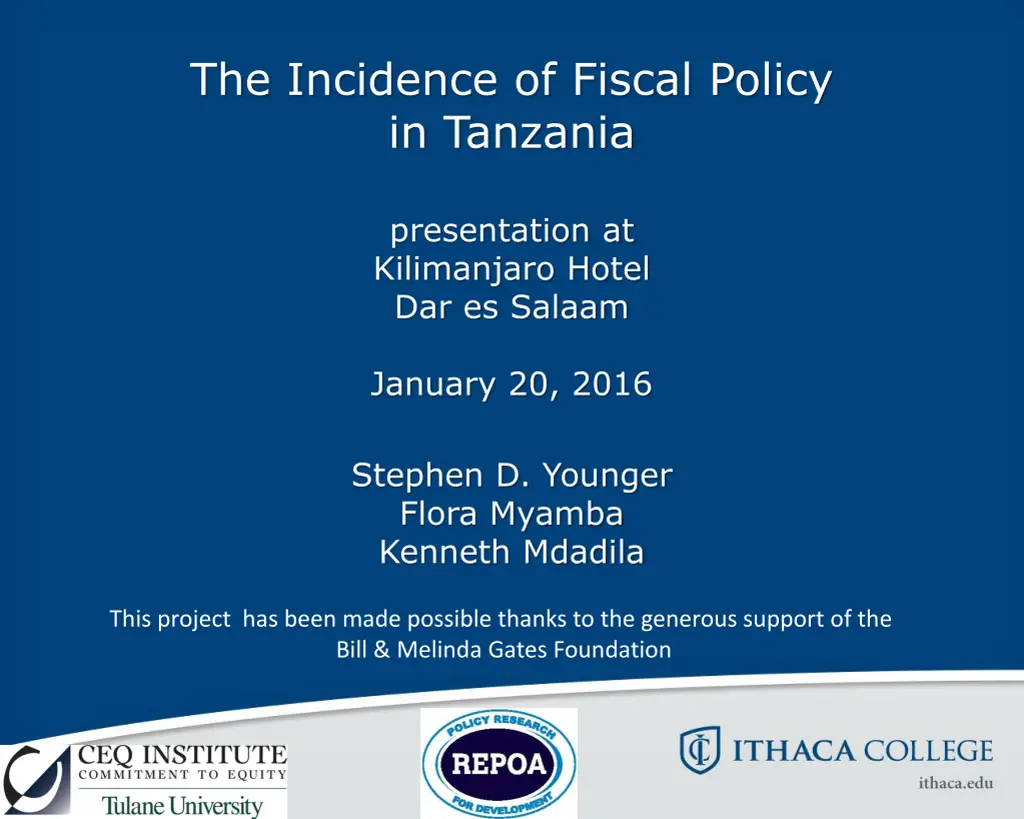
Incidence Analysis of Fiscal Policy in Tanzania
Explore the incidence analysis of fiscal policy in Tanzania, focusing on taxation, government spending, and income distribution. Understand the impact on poverty reduction and social welfare, while considering changes in taxation and spending for increased equity and efficiency.
Download Presentation

Please find below an Image/Link to download the presentation.
The content on the website is provided AS IS for your information and personal use only. It may not be sold, licensed, or shared on other websites without obtaining consent from the author. If you encounter any issues during the download, it is possible that the publisher has removed the file from their server.
You are allowed to download the files provided on this website for personal or commercial use, subject to the condition that they are used lawfully. All files are the property of their respective owners.
The content on the website is provided AS IS for your information and personal use only. It may not be sold, licensed, or shared on other websites without obtaining consent from the author.
E N D
Presentation Transcript
The Incidence of Fiscal Policy in Tanzania presentation at Kilimanjaro Hotel Dar es Salaam January 20, 2016 Stephen D. Younger Flora Myamba Kenneth Mdadila This project has been made possible thanks to the generous support of the Bill & Melinda Gates Foundation
Introduction What is an incidence analysis? Who pays taxes, and who benefits from government spending? Defined by population sub-groups, usually income- based Can do this for very specific budget items e.g. CCT or tobacco excises Or the entire budget (more or <much> less) Problem of public goods Problem of survey information CEQ tries to do the latter, and provides useful information on the former, too.
Introduction Three big questions: How much redistribution and poverty reduction is being accomplished through social spending, subsidies and taxes? How progressive are revenue collection, subsidies, and government social spending? and Within the limits of fiscal prudence, what could be done to increase redistribution and poverty reduction through changes in taxation and spending? A caution on equity and efficiency
Methods Data to describe the distribution of income come from HBS, 2011/12 The CEQ income concepts (figure next slide) Note: we are not using the welfare variable that NBS uses in poverty analysis For each CEQ income concept, we calculate Gini coefficients and FGT poverty measures For each social expenditure and tax, we calculate concentration coefficients
CEQ Income Concepts Market Income + Contributory pensions Market Income plus Pensions - - + + Direct taxes Direct transfers Gross Income Net Market Income - + + Direct taxes Direct transfers Disposable Income - - + + Consumption taxes Consumption subsidies Disposable Income plus Consumption subsidies Disposable Income minus Consumption Taxes + - + Consumption subsidies Consumption taxes Market Income minus Direct Taxes minus Consumption Taxes Market Income plus Direct Transfers plus Consumption Subsidies Consumable Income + Monetized value of education and health services + + Net Market Income plus All Transfers Market Income plus All Transfers Final Income
Whats Included in the Study? Taxes Expenditures Direct Taxes PAYE Skills Development Levy Presumptive taxes (informal) Indirect Taxes VAT Import duties Excises Petroleum products Beverages Tobacco products Communications services Direct Transfers CCT (simulated) Assistance with school books, uniforms Assistance with bed nets Pensions* (simulated) Indirect Transfers Electricity subsidies Fertilizer subsidies In-Kind Benefits Public schooling (various levels) Public health services, inpatient Public health services, oupatient
First Main Result How much redistribution and poverty reduction is being accomplished through social spending, subsidies and taxes? z=Tsh 26,085 per month Headcount index z=$1.25 per day Headcount index z=$2.50 per day Headcount index z=$4.00 per day Headcount index Poverty line: z=Tsh 36,482 per month Headcount index Poverty Gap 0.068 0.078 0.067 0.069 0.067 0.066 0.092 0.090 0.053 Gini Market Income plus Pensions Market Income* 0.382 0.379 0.381 0.358 0.357 0.360 0.341 0.345 0.331 0.283 0.294 0.280 0.285 0.282 0.278 0.353 0.348 0.250 0.101 0.111 0.097 0.101 0.097 0.096 0.145 0.144 0.073 0.437 0.447 0.432 0.441 0.436 0.432 0.521 0.515 0.416 0.835 0.837 0.833 0.845 0.844 0.839 0.889 0.883 0.855 0.937 0.945 0.937 0.947 0.946 0.944 0.966 0.963 0.954 Gross Income Net Market Income Disposable Income Disposable Income plus Indirect Subsidies Disposable Income less Indirect Taxes Consumable Income Final Income Note: Tsh poverty lines in per adult equivalents; US$ poverty lines per capita
First Main Result Social expenditures in Tanzania do relatively little to redistribute income and reduce poverty Taxes, both direct and to a lesser extent indirect, reduce inequality Direct taxes do not fall on the poor, but indirect taxes do, increasing poverty In-kind benefits from public education and health expenditures lower poverty enough to offset the effect of indirect taxes
Overall Assessment Given other countries experience, Tanzania does well: about 5 percentage points better than expected for inequality Tanzania has low GDP per capita Tanzania has low initial inequality Broadly speaking, both taxes and in-kind benefits help to reduce inequality On poverty, indirect taxes increase it, while in-kind benefits more than compensate that
More Detail Intuitively, for a tax or expenditure to have a big effect on the distribution of income, it must be: well-targeted, and large compared to incomes So let s dig into those two characteristics
How We Measure Inequality and Targeting Gini coefficient Values from zero (perfect equality) to one (perfect inequality) Practical ranges from about 0.25 (Slovenia, Scandinavia) to 0.70 (South Africa, Namibia, Brazil) Concentration coefficient Values from negative one (completely concentrated in the poorest) to one (completely concentrated in the richest) Practical ranges depend on the thing we are measuring
Standards for Good Concentration Coefficients For taxes, they should be greater than the Gini coefficient to be progressive For expenditures meant to redistribute, they should be (strongly) negative This is true even though an expenditure that has a positive c.c. that is less than the Gini will be equalizing For expenditures meant to be universal, they should be close to zero
Concentration Coefficients Concentration Coefficient Concentration Coefficient Taxes Expenditures Direct Taxes PAYE Skills development levy Presumptive taxes (informal) Indirect Taxes VAT Import duties Excises Gasoline Kerosene Lubricants and other fuels Communications services Soft drinks Bottled water Beer Wine Spirits Tobacco Direct Transfers CCT (simulated) Food assistance, NFRA Assistance w/ bed nets Assistance w/ school uniforms Assistance w/ school books Indirect Transfers Electricity subsidies Fertilizer subsidies In-Kind Benefits Public schooling Pre-primary Primary Senior High School Vocational training Post-secondary Public health care Dispensaries, out-patient Dispensaries, in-patient Health centre/clinic, out-patient Health centre/clinic, in-patient Hospital, out-patient Hospital, in-patient 0.91 0.92 0.65 -0.50 0.05 0.10 0.17 0.27 0.53 0.38 0.69 0.12 0.37 0.28 0.57 0.59 0.55 0.76 0.59 0.87 0.49 0.34 -0.12 -0.08 0.14 0.45 0.62 0.01 0.04 0.07 0.16 0.21 0.33 0.38 Gini Coefficient for Market Income
Second Main Result Expenditures Education is very progressive at lower levels, not at tertiary level Vocational training is perhaps surprising Health is almost evenly spread across the income distribution for basic services, but not hospitals Electricity subsidy is regressive; fertilizer subsidy is almost evenly distributed CCT (simulated) is extremely progressive Other forms of quasi-cash assistance are not well- targeted to the poor May reflect measurement error
Second Main Result Taxes Direct taxes (PAYE, SDL, and taxes paid by household business owners) are highly progressive VAT is more progressive than one would expect Import duties and petroleum excises are neutral Tobacco and kerosene duties are regressive The beverage excises are all progressive Communications services excise is progressive
Taxes in Tanzania Share of total Government Revenue Comparable HBS 2011/12 Estimate Included in CEQ analysis? amount (millions) 8,695,951 6,625,550 2,430,208 1,129,469 138,901 751,687 410,151 4,029,301 1,975,545 497,687 1,419,383 872,399 116,237 34,293 150,543 53,217 78,502 101,706 12,486 100,084 1,347,720 43,091 195,525 2,027,309 Share of GDP 21.1% 16.1% 5.9% 2.7% 0.3% 1.8% 1.0% 9.8% 4.8% 1.2% 3.5% 2.1% 0.3% 0.1% 0.4% 0.1% 0.2% 0.2% 0.0% 0.2% 3.3% 0.1% 0.5% 4.9% Total Revenue and Grants Taxes Direct Taxes Personal Income Tax (PAYE) Skills Development Levy Corporate Income Tax Other Direct Taxes 1/ Indirect Taxes VAT 2/ Import Duties 2/ Excises petroleum excises 2/ communications services tax Bottled Water and Soft Drinks Beer Wine/Spirits/Konyagi Tobacco Other (imports) Other Other Indirect Taxes Social Insurance Withholding /3 Non-Tax Revenues LGA Revenues Grants 76.2% 1,262,396 1,177,232 67,786 13.0% 1.6% 8.6% 4.7% 46.3% 22.7% 5.7% 16.3% 10.0% 1.3% 0.4% 1.7% 0.6% 0.9% 1.2% 0.1% 1.2% 15.5% 0.5% 2.2% 23.3% yes yes no 17,378 partial 1,972,045 497,883 yes yes 770,878 148,737 27,192 2,816 2,591 6,566 yes yes yes yes yes yes no no no yes no no no 1,197,811 58.0% NOTE: Share of Government Revenue Included in Analysis: NOTE: Share of GDP Included in Analysis: 12.3%
Expenditures in Tanzania Comparable HBS 2011/12 Estimate Share of total Government Spending Included in CEQ analysis? amount (millions) 12,902,764 3,062,712 59,925 Share of GDP 31.37% 7.45% 0.15% Total Expenditure Social Spending Social Protection Social Assistance of which Conditional or Unconditional Cash Transfers Noncontributory Pensions Near Cash Transfers (Food, School Uniforms, etc.) Other Social Insurance of which 3/ Old-Age Pensions Education of which Pre-school Primary Secondary Post-secondary non-tertiary and vocational Tertiary Health of which Contributory Noncontributory Housing & Urban of which Housing Subsidies of which Energy of which Electricity Fuel Food On Inputs for Agriculture (NAIVS) Infrastructure of which Water & Sanitation Rural Roads Interest 23.7% 0.5% 540 no 0.0% 0.00% - 26,525 37,800 partial 0.3% 0.0% 7.4% 7.3% 14.7% 0.09% 0.00% 2.33% 2.29% 4.60% 957,645 943,501 1,891,092 957,428 yes 95,778 1,051,832 409,279 41,865 416,630 607,868 - 752,817 386,994 44,177 573,075 643,150 yes yes yes yes 5.8% 3.0% 0.3% 4.4% 5.0% 1.83% 0.94% 0.11% 1.39% 1.56% - 607,868 643,150 6,392 6,392 yes no no 5.0% 0.0% 0.0% 1.56% 0.02% 0.02% 1.15% 0.83% 0.45% 0.38% 0.07% 0.25% 6.77% 1.16% 5.61% 3.83% 341,096 185,904 155,192 28,500 103,500 2,783,558 477,066 2,306,492 1,576,800 2.6% 1.4% 1.2% 0.2% 0.8% 21.6% 3.7% 17.9% 12.2% 262,554 yes no yes yes no no no no 50,962 0 NOTE: Share of Government Spending Included in Analysis: NOTE: Share of GDP Included in Analysis: 20.2% 6.3%
How Does Tanzania Compare to Other Countries? El South Africa (2010) 2/ Average $11,833 Ethiopia (2011) $1,163 Tanzania (2012) $2,201 Ghana (2013) /1 $3,737 Bolivia (2009) $5,090 Guatemala (2010) $6,474 Armenia (2011) $7,045 Salvador (2011) $7,389 Indonesia (2012) 1/ $9,017 GNI per capita (2011 PPP) $5,994 % of GDP Direct Taxes Indirect and Other Taxes Cash and Near-cash Transfers Education Spending Health Spending 3.9% 7.8% 1.3% 4.6% 1.2% 5.9% 9.8% 0.3% 4.6% 1.6% 6.7% 7.8% 0.2% 5.7% 1.7% 5.7% 21.1% 2.0% 8.3% 3.6% 3.3% 8.9% 0.5% 2.6% 2.4% 5.2% 11.9% 2.5% 3.5% 1.7% 5.2% 10.3% 1.4% 2.9% 4.3% 5.6% 6.3% 0.4% 3.4% 0.9% 14.3% 12.8% 3.8% 7.0% 4.1% 6.2% 10.7% 1.4% 4.7% 2.4% Gini, Market Income 0.32 0.38 0.44 0.50 0.55 0.47 0.44 0.39 0.77 0.47 Concentration Coefficients Direct Taxes Indirect and Other Taxes Cash and Near-cash Transfers Education 0.60 0.37 -0.37 0.91 0.47 0.10 0.73 n.a. 0.44 -0.37 0.85 0.43 -0.31 0.62 0.38 -0.30 0.82 n.a. 0.42 -0.27 0.90 0.69 -0.27 0.77 0.44 -0.23 0.37 -0.07 0.35 -0.25 Pre-primary Primary Secondary Tertiary n.a. -0.03 0.27 0.41 0.07 0.40 -0.12 -0.08 0.14 0.62 0.18 0.59 -0.34 -0.27 0.01 0.62 0.04 0.43 -0.21 -0.25 -0.12 0.30 -0.04 0.37 -0.10 -0.18 0.03 0.59 0.18 0.10 -0.05 -0.18 -0.04 0.25 0.01 n.a. -0.20 -0.22 0.02 0.44 0.12 n.a. n.a. -0.08 -0.11 -0.19 -0.12 0.50 -0.06 -0.16 -0.16 0.02 0.47 0.07 0.37 0.47 0.12 0.34 Health Indirect Subsidies
A Note on Coverage Coverage measures the share of the target population that a particular expenditure actually reaches or benefits This is a way to measure targeting of an expenditure Errors of exclusion Errors of inclusion Different for each expenditure Not the same concept as incidence
Coverage of Social Spending $1.25< y <$2.50 $2.50< y <$4.00 $4.00< y <$10.00 $10.00<y y<$1.25 Education Pre-school, public Pre-school 0.15 0.16 0.13 0.17 0.14 0.24 0.10 0.24 0.07 0.44 Primary, public Primary 0.68 0.69 0.77 0.80 0.76 0.82 0.63 0.86 0.51 0.87 Secondary, Public Secondary 0.23 0.24 0.33 0.39 0.38 0.51 0.38 0.58 0.27 0.59 Health Hospital 0.03 0.02 0.02 0.01 0.05 0.05 0.06 0.03 0.03 0.02 0.06 0.05 0.08 0.04 0.03 0.02 0.07 0.05 0.11 0.07 0.03 0.02 0.05 0.03 0.15 0.08 0.03 0.02 0.04 0.01 Hospital, public Center Center, public Dispensary Dispensary, public Social Security Pension 0.00 0.01 0.02 0.03 0.02 Infrastructure Electric mains 0.04 0.33 0.16 0.41 0.41 0.59 0.60 0.64 0.82 0.75 Piped water or borehole
Results Coverage Education coverage NOTE: these are not GERs or NERs Coverage is less-than complete at primary level and drops off considerably at higher levels Note the heavy use of private schools in the upper quintiles Health coverage More difficult to judge adequacy Note the heavy use of hospitals relative to other services Old-age pensions coverage Very limited, even among the highest quintile Note the inequity of access to electricity
Poverty Status Transitions Average Market Income (Tsh per mo) $1.25 <= y < $2.50 Disposable Income groups $2.50 <= y < $4.00 $4.00 <= y < $10.00 y < $1.25 >= $10.00 Percent of Population Market Income groups y < $1.25 99% 1% 0% 0% 0% 1% 99% 8% 4% 3% 0% 0% 92% 13% 1% 0% 0% 0% 83% 32% 0% 0% 0% 0% 65% 44% 40% 10% 5% 1% 25,492 49,911 89,585 163,444 512,202 $1.25 <= y < $2.50 $2.50 <= y < $4.00 $4.00 <= y < $10.00 >=$10.00 Consumable Income groups y < $1.25 100% 19% 0% 0% 1% 0% 80% 44% 6% 2% Final Income groups 0% 0% 56% 41% 2% 0% 0% 0% 53% 57% 0% 0% 0% 0% 39% 44% 40% 10% 5% 1% 25,492 49,911 89,585 163,444 512,202 $1.25 <= y < $2.50 $2.50 <= y < $4.00 $4.00 <= y < $10.00 >=$10.00 y < $1.25 90% 6% 0% 0% 1% 10% 91% 29% 5% 1% 0% 3% 67% 35% 2% 0% 0% 4% 60% 53% 0% 0% 0% 0% 44% 44% 40% 10% 5% 1% 25,492 49,911 89,585 163,444 512,202 $1.25 <= y < $2.50 $2.50 <= y < $4.00 $4.00 <= y < $10.00 >=$10.00
Simulating Policy Changes The analysis is descriptive of the status quo as of 2011/12, the time of the HBS But we can use it to simulate the first-order effects of policy changes Some examples follow: Switch from import duties to direct taxes Eliminate electricity subsidies Expand the CCT coverage Institute a social pension
Change to Direct Taxation Simulation: Shift All Import Duties to PAYE Extreme Poverty Headcount -0.005 -0.003 Poverty Headcount -0.007 -0.007 Poverty Gap -0.002 -0.001 Change in: Consumable Income Final Income Gini -0.004 -0.003
Eliminating Electricity Subsidy Simulation: Elimination the Electricity Subsidy and Use the Resources to Expand CCT Simulation Change in: (1) (2) (3) -0.0140 -0.0148 -0.0163 -0.0068 -0.0108 -0.0094 0.00% (4) -0.0022 -0.0004 -0.0031 -0.0018 -0.0055 -0.0050 0.34% Disposable Income Consumable Income Final Income Disposable Income Consumable Income Final Income Poverty Headcount 0.0029 0.0019 0.0024 0.0013 Gini -0.0036 -0.0034 0.43% -0.0020 -0.0019 0.27% Budgetary savings (% of GDP): (1) Eliminates the Electricity Subsidy with no compensation (2) Eliminates subsidy except for lifeline tariff for first 50kwh, which is held constant. (3) Eliminates electricity subsidy and uses all the funds to expand CCT coverage by raising PMT threshhold (4) Eliminates electricity subsidy and uses enough funds to expand CCT to leave poverty roughly unchanged.
Expanding CCT Simulation: Expand CCT in various ways, using increased VAT to pay for it Simulation Change in: (1) (2) (3) -0.0236 -0.0146 -0.0191 -0.0087 -0.0108 -0.0095 1.00 Disposable Income Consumable Income Final Income Disposable Income Consumable Income Final Income Note: Scaling Factor Poverty Headcount -0.0104 -0.0117 -0.0138 -0.0159 Gini -0.0063 -0.0053 0.55 -0.0094 -0.0080 1.00 (1) Expands CCT to all eligible persons, then scales benefits down so the total CCT expenditure is 0.5% of GDP (2) Expands CCT at current benefit rates to the poorest eligible people according to the proxy means test until total CCT payments are 0.5% of GDP. (3) Expands CCT at current benefit rates to the poorest people regardless of VC/elderly according to the proxy means test until total CCT payments are 0.5% of GDP.
Establish a Social Pension Simulation: Establish a social pension, with and without VAT to fund it Simulation Change in: (1) (2) Disposable Income Consumable Income Final Income Disposable Income Consumable Income Final Income Note: Net cost, %GDP Poverty Headcount -0.0048 -0.0069 -0.0134 -0.0123 Gini -0.0059 -0.0054 0.0% -0.0037 -0.0032 0.5% (1) Social pension of Tsh 11,000 per month for all people >=60 years, financed with increased VAT (2) Social pension of Tsh 11,000 per month for all people >=60 years, not financed
Conclusions Tanzania does quite a lot to redistribute resources given its relative poverty and initial equality Indirect taxes increase poverty substantially, while direct taxes do not In-kind benefits of education and health expenditure reduce poverty substantially
Conclusions Most taxes in Tanzania are well-targeted to the better off PAYE Presumptive taxes on small businesses VAT Most excises (beer, wine, soft drinks, bottled water, communications services) But also some poorly-targeted ones Tobacco Kerosene And some neutral ones Petroleum excises Import duties
Conclusions Tanzania has relatively few well-targeted expenditures Public primary school CCT (with a caveat) And some very poorly targeted ones Electricity subsidies Tertiary education
Conclusions Third big question: Within the limits of fiscal prudence, what could be done to increase redistribution and poverty reduction through changes in taxation and spending? First, let s remember my caution from the introduction This is about equity But efficiency matters, too
Conclusions There are some attractive options from an equity perspective eliminate electricity subsidies expand the CCT reduce kerosene excises increase some progressive excises expand coverage and improve the quality of public primary (and perhaps secondary) education


